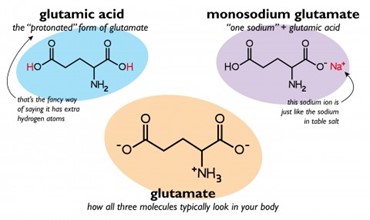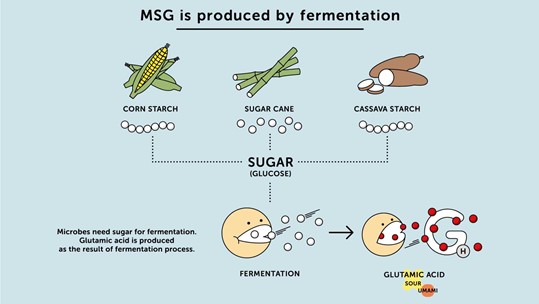To Eat or Not to Eat: The Persistent Questionability of MSG
This month we will be featuring a series of posts from student’s in MET ML 619, The Science of Food and Cooking, with Professor Valerie Ryan. Today’s post is submitted by Gastronomy student María José Córdova.
Is MSG a Chemical?
Over one hundred years since its isolation and fifty years since the “discovery” of the Chinese Restaurant Syndrome (CRS), the safety and status of monosodium glutamate (MSG) remains debatable among laypeople. Initial distrust of MSG’s safety may have been fueled by both chemophobia and xenophobia, but the reason for its persistence appears to be less clear. Negative attitudes about MSG are often based on a legacy of misunderstanding and misinformation. Here, I endeavor to develop an overview of MSG’s origins, chemistry, and production that may better inform the individual’s opinion on MSG and dispel some lingering mistrust.
The Chemistry

MSG is the sodium salt of glutamic acid (Wang & Adhikari 2018). Glutamate is a naturally occurring amino acid that dissolves into free glutamic acid. Free glutamate is found in a variety of foods like tomatoes, parmesan cheese, and seaweed and is naturally found in our bodies (Taliaferro 1995). Glutamic acid is a nonessential amino acid with a variety of functions, one of which is to act as a neurotransmitter.
In 1908, Japanese chemist Kikunae Ikeda succeeded in isolating glutamic acid and identifying it as responsible for the savory taste of konbu dashi (sea kelp broth). Ikeda called this taste umami and proceeded to develop a crystalline powder via a chemical process. Thus emerged monosodium glutamate, which Ikeda patented and later founded Ajinomoto, a company that continues to mass-produce MSG today (Ikeda 2002).
Various methods exist for producing MSG. The most common way to produce MSG today is through the fermentation of plant-based ingredients like sugar cane or corn (Ault 2004, Sand 2005). According to the Ajinomoto website, after the fermentation process produces glutamic acid, the solution is decolorized, filtered, and crystallized, yielding the MSG powder that we recognize (“What is MSG and how is it made?”). This is the powder that made its way into many foods across the U.S. food supply for decades before facing questions about its safety.

The MSG Symptom Complex
In 1968, the New England Journal of Medicine published a letter from Chinese American doctor Robert Ho Man Kwok entitled “Chinese Restaurant Syndrome” in 1968. Kwok’s letter described a syndrome which produced “a numbness at the back of the neck, gradually radiating to both arms and the back, general weakness and palpitations” (796). While Kwok’s letter is not definitive about MSG’s causal role in producing these symptoms, he does isolate this experience to dining at Chinese restaurants and coins the term “Chinese Restaurant Syndrome” (CRS). The following month after Kwok’s letter was published, The New England Journal of Medicine published eleven different correspondences on CRS that express relief and identify with Kwok’s experience. Few suspect MSG is the cause. Instead, they focus on the experience occurring after consuming food at Chinese restaurants (1968, 1122-1124). The first of these correspondences is from H. Schaumburg, a professor of neurology who published a study on the effects of MSG the following year. His research both legitimized CRS as a medical condition and determined MSG was the cause. Schaumburg also pointed out that MSG was widely used as a food additive which widened the scope of the issue beyond Chinese restaurants (Mosby 2009). While Schaumburg’s and other subsequent studies have since been questioned or delegitimized for their faulty methodologies, their legacy persists.
Anti-MSG attitudes in the United States are associated with medical ailments and racialized with terms like “Chinese Restaurant Syndrome” (CRS). It becomes difficult to separate anti-MSG campaigns from anti-Asian ones. In the U.S., there exists a long history of systemic xenophobia, first codified with the 1882 Chinese Exclusion Act (Wahlstedt et al. 2022). To specifically associate MSG with Chinese cuisine when it had been used for decades in processed food is indicative of xenophobic bias by medical professionals. Moreover, media seized upon the early correspondences to spread misinformation that was, up to this point, based on anecdotal evidence. However, today we see consumer preference for natural foods and a fear of chemicals continues to fuel a mistrust of MSG.
The Chemophobia
While there is scientific consensus that MSG is not unsafe, studies on consumer attitudes demonstrate that negative attitudes toward MSG are shaped by consumers’ chemophobia and misinformation about MSG (Wang and Adhikari, 2018). Several studies also show that many of the initial studies performed on MSG produced questionable results based on flawed methodology (Freeman 2006; Geha et al. 2000; Taliaferro 1995; Wahlstedt et al. 2022).

In the simplest terms, chemophobia is the fear of chemicals. In “Food Chemistry and Chemophobia,” Gordon W. Gribble suggests that the advent of chemophobia occurred in the wake of Rachel Carson’s ‘Silent Spring’ and the environmental movements of the era. Such reports moved the public to distrust the chemical industry. Gribble argues that, ultimately, everything we “see, smell, and touch is chemical!” and that the media uses the terms aroma, bouquet, fragrance, and odor are euphemisms for the volatile chemicals we breath (2013, 178). For Gribble, the breakdown of everything around us into molecules renders it a chemical because of chemistry. Moreover, he believes that “The Dose Makes the Poison” and argues that, in excess, the ingestion of natural compounds like water or salt are fatal.
While Gribble’s approach is extreme, it is evidence-based and works to reset the baseline for what is chemical and what makes a chemical dangerous. Gribble does not discuss MSG, but his argument touches on the tension between natural and artificial chemistry. Wang and Adhikari’s study on consumer perceptions about MSG concluded that subjects with a preference for natural food were more concerned about MSG which coincided with a general fear of chemicals. Additionally, the researchers found that many of their subjects misunderstood the function of MSG and believed it to be high in sodium when it contains less sodium than sodium chloride (2018).
Contemporary articles on MSG and its safety tend to agree that MSG has been misconstrued to be seen as unsafe due to misinformation and a history of questionable research methodologies, both of which contribute to the public’s mistrust of MSG.
Future Research
As of now, scientific research has not proved that MSG is bad for our health. Studies performed in the wake of Kwok’s original correspondence have since been discredited for only testing a handful of subjects that produced biased results. Anti-MSG messaging has largely been based on misinformation and personal experiences and xenophobic responses. However, this cultural response has had a long-lasting impact on American attitudes towards MSG. In recent years, anti-MSG sentiment stems more from chemophobia, yet the impact is similar because of the historical link between MSG and anti-Asian attitudes.
Future research should endeavor to explore a more nuanced approach to the bias against MSG and the link between consumer’s attitudes and cultural bias. Such a study may be more subjective but could illuminate whether anti-Asian sentiments continue to affect consumers’ opinion on MSG and perhaps where consumers first met anti-MSG messaging. As has been overviewed here, anti-MSG attitudes have largely been shaped by a serious of unfortunate events that sowed distrust while also capitalizing on anti-Asian xenophobia. Such a legacy is difficult to undo but doing so would leave the public better suited to understand their implicit bias, its origins, and ways to move forward.
Works Cited
Ault, Addison. “The Monosodium Glutamate Story: The Commercial Production of MSG and Other Amino Acids.” Journal of Chemical Education 81, no. 3 (2004): 347-55.
Freeman, Matthew. “Reconsidering the Effects of Monosodium Glutamate: A Literature Review.” Journal of the American Academy of Nurse Practitioners 18, no. 10 (2006): 482–86. https://doi.org/10.1111/j.1745-7599.2006.00160.x
Geha, Beiser, A., Corren, J., Saxon, A., Ren, C., Patterson, R., Greenberger, P. A., Grammer, L. C., Ditto, A. M., Harris, K. E., Shaughnessy, M. A., & Yarnold, P. R. “Review of alleged reaction to Monosodium glutamate and outcome of a multicenter double-blind placebo-controlled study.” The Journal of Nutrition, 130 (4), (2000): 1058S–1062S. https://doi.org/10.1093/jn/130.4.1058S
Gribble, G.W. “Food chemistry and chemophobia.” Food Security. 5, no. 2 (2013): 177–187. https://doi-org.ezproxy.bu.edu/10.1007/s12571-013-0251-2
Ikeda, Kikunae. 2002. “New Seasonings.” Chemical Senses, 27, 847-849.
Kwok, R. H. “Chinese-restaurant syndrome.” New England Journal of Medicine. 278, no. 14 (1968):796.
Mosby, Ian. “‘That Won-Ton Soup Headache’: The Chinese Restaurant Syndrome, MSG and the Making of American Food, 1968–1980.” Social History of Medicine: The Journal of the Society for the Social History of Medicine 22, no. 1 (2009): 133–51. https://doi.org/10.1093/shm/hkn098
Sand, Jordan. “A Short History of MSG: Good Science, Bad Science, and Taste Cultures.” Gastronomica: The Journal of Food and Culture, 5, no. 4 (2005): 38-49.
Schaumburg, H. “Chinese-Restaurant Syndrome.” The New England Journal of Medicine 278, no. 20 (1968): 1122-124.
Taliaferro, Patricia J. “Monosodium glutamate and the Chinese Restaurant Syndrome: a review of food additive safety.” Journal of Environmental Health, 57, no. 10 (1995): 8-12.
Wahlstedt, Amanda, Elizabeth Bradley, Juan Castillo, and Kate Gardner Burt. “MSG Is A-OK: Exploring the Xenophobic History of and Best Practices for Consuming Monosodium Glutamate.” Journal of the Academy of Nutrition and Dietetics 122, no. 1 (2022): 25-29.
Wang, Shangci and Koushik Adhikari. “Consumer Perceptions and Other Influencing Factors about Monosodium Glutamate in the United States.” Journal of Sensory Studies 33, no. 4 (2018): e12437-n/a. doi:10.1111/joss.12437.